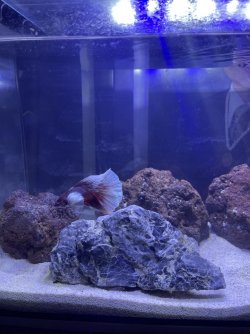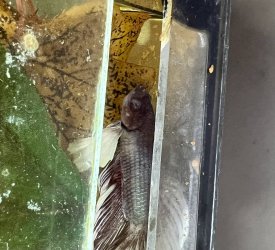jayveechun
New Member
Hi. I am hoping for some help and insight for my sick betta, Norbert. Let me know if you guys have other diagnoses for him as Im not sure what he has but hopefully the items below shed more light for more insight.
Symptoms:


Symptoms:
- He has been off-feed for a week. There was 1 day he ate 3 pellets but thats pretty much it within the span of time.
- His face scales have sort of been raised with a small red sore. I'm not certain where this is from BUT I did catch him one day burying his face against catappa leaves which I assume is a way to scratch his face.
- There is a small yellow patch on his cheek covering the gill flaps
- He just sleeps all day on top of my betta hammocks.
- I assumed this was parasitic in nature (lice? flukes? velvet?) given the distress is localized to the face plus the red spots.
- So I started a 2 week Seachem Paraguard treatment. 2.5ml per morning in his 5 gallon tank. Were on day 5.
- Since the wound became obvious a few days later, I panicked and also added Seachem Kanaplex as an antibiotic. Were 2 days in (given per 48 hours)
- Honestly, he never really perked up or considered eating again despite being 5 days into treatment and I am afraid Im doing the wrong things or misdiagnosing.
- I currently have in my medicine cabinet Melafix, Pimafix, Seachem Kanaplex, Seachem Metroplex, API general cure, and Seachem Paraguard. Im so tempted to change or add but not knowing the diagnosis makes pickign medication scary. I tried using the least medication with the broadest indications to cover bases.
- Ive had him since July 2021 so 7 months in. He was sold to me apparently at 6 months age. So that makes him a year old.
- He stays in a 5 gallon tank with a low flow sponge filter.
- Temp is 78-81F as Im in the tropics.
- His place is littered with catappa leaves for tannins.
- His diet is Hikari Pellets given twice daily, 5-6 pellets per feeding. Sometimes I give freeze dried tubiflex for treats.
- Maintenance is 40% weekly water changes. I use Seachem Prime to dechlorinate, and then both Seachem Stability and API Stress zyme to supplement beneficial bacteria.
- Parameters are always ammonia 0ppm, nitrite 0ppm, nitrate ranging from 0-10ppm




 like is it a specific disease?
like is it a specific disease?
